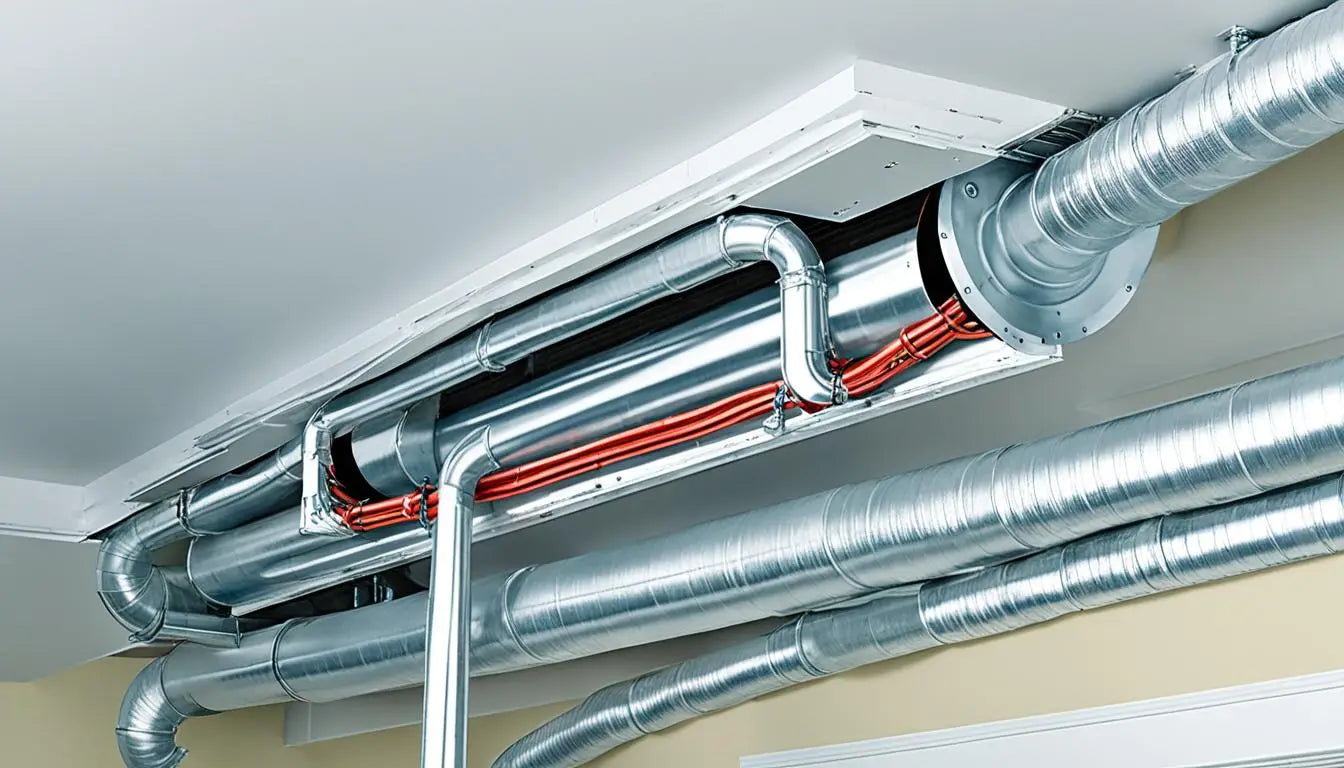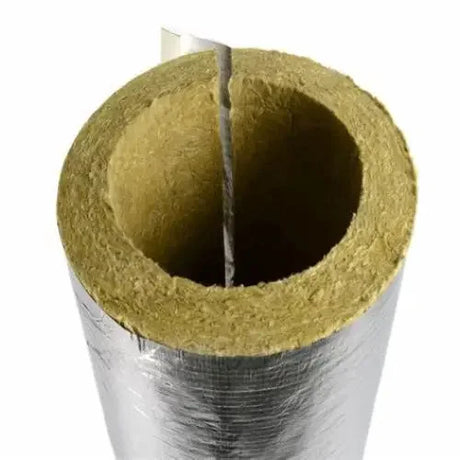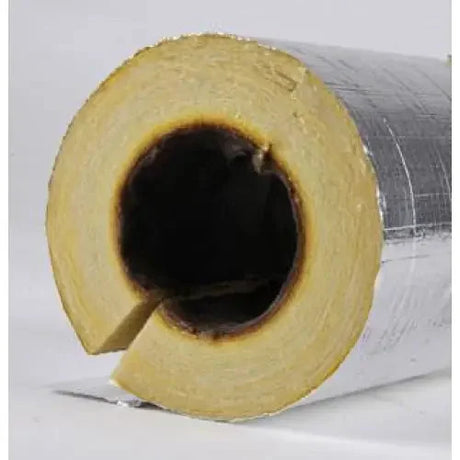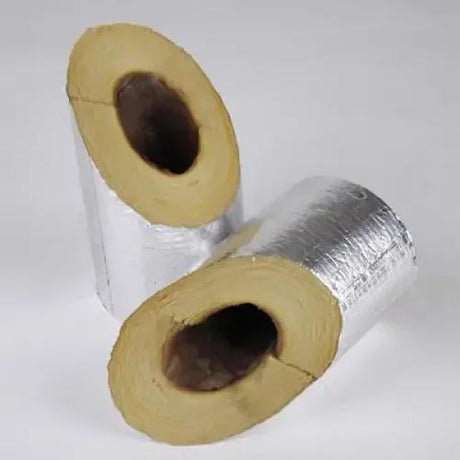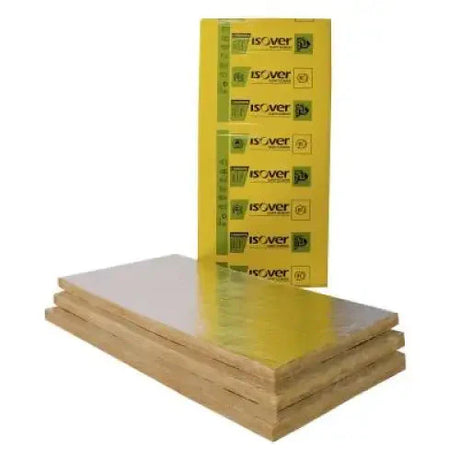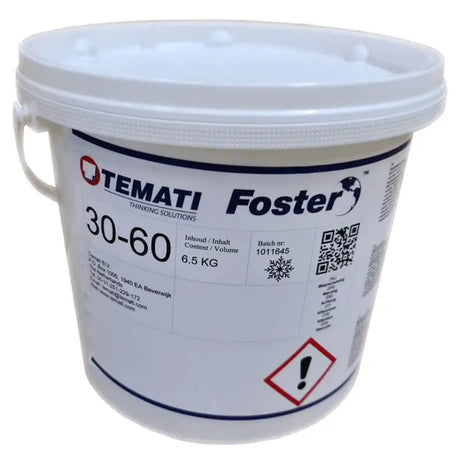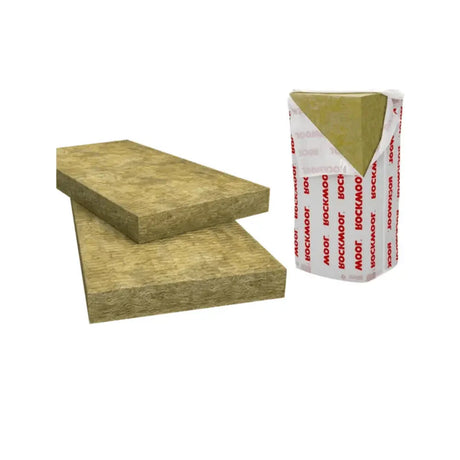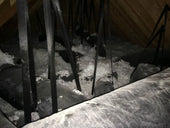Hidden inside your walls, the network of HVAC ducts plays a big part in your system's efficiency and cost-effectiveness. With up to 40% of energy lost in duct systems placed in attics or crawl spaces1, it's vital to know the details of ductwork installation. This guide brings you top advice for both residential and commercial HVAC duct installation, leading to better comfort and more energy savings.
Our expert guide helps you understand professional duct installation services better. It's perfect for duct installation companies and property owners who want top-performing systems and lower costs. Our tips and insights prepare you for effective duct system installation.
In HVAC duct installation, every little bit matters. From the ductwork contractors' plans to the materials used, everything makes a difference. Following standards like BS EN ISO 16890 for air filters2 and choosing the right duct sizes2 sets you up for a future of efficiency and eco-friendliness.
Key Takeaways
- Identify essential tips and best practices for efficient HVAC duct installation.
- Explore the pivotal role of professional duct installers in enhancing system efficiency.
- Delve into the importance of following industry standards and regulations for ductwork installation.
- Understand the financial and environmental implications of proper residential duct installation.
- Discover how commercial entities can benefit from upgrading to contemporary commercial HVAC duct installation.
Understanding the Fundamentals of HVAC Ductwork
The way your heating, ventilation, and air conditioning (HVAC) system works depends a lot on the ductwork. It's how air gets moved around in a space. Knowing how HVAC ductwork works is crucial for making a place comfortable to stay in.
Defining HVAC Ducts and Functionality
At the heart of any HVAC system, the ductwork moves warm or cool air to different spots. The ducts are planned carefully to make sure air spreads out evenly. This helps keep the climate steady throughout the year.
Materials and Composition: From Sheet Metal to Fiberglass
Many materials are used to make ductwork because each has its good points. Sheet metal ducts, like those made of galvanised steel, are strong and don't rust. This makes them last a long time3. For places like hospitals, aluminium is better because it doesn’t rust easily and is light, though it does cost more3.
On the other hand, fiberglass ductwork is chosen for its quietness and doesn’t corrode easily. But, it might wear out and release tiny fibres into the air3. Fiberboard ducts are great for keeping air in and are insulated but not ideal for letting air flow because they're made from fiberglass strands and resin3.
Flexible ducts are often used because they bend easily. They have a plastic layer inside, metal wire around it, and fiberglass on the outside for insulation3.
Choosing the right material for your ducts is more than about the cost or how long it will last. It depends on what the building needs and how it affects the environment. The main goal is to find a balance between making a place comfortable and being efficient. This heavily relies on using quality ducts and keeping them in good shape3.
Essential Materials for Superior Ductwork Installation
Installing HVAC systems requires expert knowledge and the right materials. By using top-grade ductwork materials, you create a strong and energy-efficient system. For example, choosing the right duct insulation can greatly lower energy use. A study found that 25 mm insulation results in about 98,860 kg of CO2 emissions yearly, while 50 mm reduces this to around 63,400 kg4.
Other key parts include fittings and connectors to keep airflow smooth. Wrong fittings can really hurt system efficiency. For a system at 15 °C with up to 3 m/s airflow4, tight connections are crucial. Also, duct supports are vital for holding up the system. They prevent damage from the stress of running it around 4,000 hours each year4.
A study in northern Europe showed savings from using 13 mm and 25 mm insulation. For gas-heated flats, savings were roughly 18,500 € and 12,000 € annually4. This shows the financial wisdom of good duct insulation.
Choosing materials is about more than just immediate results. For example, using modern insulation like U PROTECT® PIPE SECTION insulation can greatly extend hot water cooling time. This changes cooling from 2h20min to over 14h, which is a +12 hours' improvement4.
HVAC Duct Installation: Step-by-Step Guidance
Starting an HVAC duct installation project needs careful planning and choosing the right materials. You also need to fit and seal everything well to make sure the system works great for a long time. By following detailed steps, you can create an efficient HVAC system that lasts.
Initial Design and Planning of Your Duct Layout
Every successful HVAC project begins with good design and planning. Guide B2 on Ventilation and Ductwork offers important advice. It covers contaminant control, how much fresh air is needed, and keeping the temperature comfortable2. It also talks about how to calculate ventilation properly to make sure the system fits the building's needs2.
Material Selection for Optimal Performance and Durability
Choosing the right materials is crucial for the system's performance and lastingness. Materials must meet standards like BS EN ISO 16890 for air filters2. The right materials help keep the structure strong, save energy, and are better for the environment. This leads to saving money and gaining benefits for the planet2.
Secure Fitting and Sealing Techniques
An airtight system is vital to avoid losing up to 30 percent of the air5. Good fitting and sealing are key in duct installation because they affect air quality and how much it costs to run the system. Using the right methods can prevent losing 57% of the system's capacity due to leaks and bad vent placement5.
Using Guide B2's advice and proper fitting and sealing is a good plan for HVAC projects. When you're updating an old system, remember to include the cost of removing old parts. This helps integrate the new system without unexpected expenses6.
| Step in Installation Process | Considerations | Expected Outcome |
|---|---|---|
| Design and Planning | Space allowances, air supply rates, contaminant control | Optimised duct layout for efficient air distribution |
| Material Selection | Conformity to BS EN ISO 16890, durability factors | Materials that support system longevity and efficiency |
| Fitting and Sealing | Leak prevention, sealing integrity, fitting accuracy | Airtight installation, reduced energy loss, stable performance |
By understanding and following key steps in HVAC duct installation, from designing the layout to picking materials and fitting and sealing, you can greatly improve your HVAC system's performance and lifespan256.
Best Practices for Efficient HVAC Duct Systems
Searching for efficient HVAC duct systems means more than just comfort. It's about saving costs and energy too. Around 20% of air can get lost in a house due to leaks in ducts, showing a big chance for betterment7. By improving your home's energy efficiency with good ductwork and insulation, you help control airflow and keep pollutants out7. This article gathers research and expert advice to show how homes can be more efficient.
Following advice from ACCA's Manual J and D helps ensure ducts are the right size. This makes air distribution better, allowing for smaller, more cost-effective heating and cooling systems7. HVAC School's tips highlight the need for quality air. They suggest using filter grilles, picking the right filter sizes, and keeping airflow efficient even with good filters8.
Here are practical tips to improve your HVAC duct system's performance and lifespan:
- Inspect and seal leaky ducts to stop air loss and prevent pollutants from getting in7,8.
- Ensure proper insulation of ductwork, especially in spots like attics and crawl spaces with big temperature changes7.
- Create a balanced airflow by making sure all rooms have pathways for return air. This helps avoid pressure issues8.
- Minimise turbulence by choosing smooth turns over sharp ones in fittings to keep airflow efficient8.
- Optimise air handler placement to make for shorter, direct air paths and lessen energy use8.
By following these tips, we can avoid the hidden costs of energy loss. Plus, we support air quality control and extend our HVAC systems' lifespans. Consider this table for further guidance:
| Aspect | Best Practice | Benefits |
|---|---|---|
| Sealing Ducts | Use mastic or foil-backed tape | Cuts down on energy loss and stops pollutants |
| Insulation | Bury attic ducts in insulation | Makes it similar to conditioned space, reduces heat loss |
| Airflow Design | Use ACCA Manual D calculations | Guarantees efficient air distribution |
| Filter Sizing | Keep sizes the same for easy change | Keeps air quality and system efficiency up |
| Air Handler Positioning | Place in the central area | Makes ducts shorter, lowers system stress |
Finally, testing for static pressure, airflow, and duct leakage is wise. This ensures your HVAC system works at its best8. In summary, adopting these energy-efficient practices, along with proper insulation and airflow balance, will not just make your home comfortable. It will also make it a model of efficiency and good air quality.
Common Challenges and Solutions in Duct Installation
Installing HVAC ductwork involves solving many problems to make the system work well and keep air clean. Facing issues like limited space and keeping out pollutants is crucial. Experts need to handle these carefully.
Navigating Issues with Space Constraints
Dealing with limited space is tough, especially in complex buildings or updates. Galvanized steel or aluminium ducts come in many shapes. This helps them fit into small spaces9. Flex ducts are light and flexible, perfect for tricky spots9.
Space optimisation can be done through custom designs. Fiberboard ducts cut noise and keep heat in. They're great when shaped for a specific area9. Each duct type has pros and cons. It's important to choose the right one for the job9.
Ensuring Clean Airflow and Preventing Contaminants
Clean ducts are key for healthy air indoors. Fiberglass ducts reduce noise but can get mouldy. Pick carefully to avoid this9. Changing air filters every three months keeps the system working well and stops clogs10.
Leaks in ducts can hurt airflow and air quality10. Early leak detection is vital and fixes should be made fast10. Sometimes, ducts need redesigning for better airflow and efficiency10.
Success in duct installation needs good planning, the right materials, and regular care. By tackling these hurdles well, experts can create top-notch HVAC systems. These systems meet the needs of today's homes and offices.
Role of Professional Duct Installers in HVAC Projects

Hiring professional duct installers and skilled ductwork contractors is vital for HVAC projects. They bring necessary skills for both homes and businesses. This ensures your systems work well and last long. Their expertise helps avoid common ductwork problems.
A well-done installation impacts your comfort and energy use. If done right, your system should last 20 to 25 years. It should also run quietly and efficiently11. According to a U.S Department of Consumer Energy Report, poor installation can waste 25-40% of energy. This highlights the need for expert installers to make the system airtight11. Not hiring skilled workers can lead to many issues. This includes poor indoor air, higher costs, mold, allergy risks, and even system failure11.
Below is a table that shows the differences between good and bad HVAC duct installations:
| Aspect | Professional Installation | Unprofessional Installation |
|---|---|---|
| Airtightness & Energy Efficiency | Leakage tests conducted, losses minimised | Energy losses up to 40%, leakage common |
| Lifespan of the System | 20-25 years with proper installation and care | Reduced lifespan, frequent issues |
| Installation Time | Efficient and timely, ranging from days to a few weeks depending on project size | Potentially, prolonged with complications |
| Performance | Noise-free, vibration-free, optimised airflow design | Noisy, inefficient airflow, increased resistance |
| Property Comfort & Health | Contributes to overall comfort, energy savings, and clean air | Risks to indoor air quality, potential for mold and allergens |
| Long-Term Costs | Cuts energy bills, minimises need for replacements | Increased heating and cooling expenses, costlier maintenances |
The value of professional duct installers and skilled ductwork contractors is clear. They're crucial for a top-notch, efficient, and affordable HVAC system. Choosing them is smart for any property owner or manager.
Testing and Balancing: Ensuring Equitable Air Distribution
Ensuring buildings are comfortable and efficient calls for a key step: testing and balancing HVAC ducts. This is covered as Chapter 38 in the 2015 ASHRAE Handbook—HVAC Applications12. It's crucial for making sure that airflow and temperature control meet the planned specs. Achieving the right air distribution is essential for the desired indoor climate.
Verification of System Airflow
To make sure every room gets its fair share of air, checking airflow is key. According to ASHRAE Guideline 0-201913, it's important to confirm airflow matches the design. This step, along with duct design principles from Chapter 19 of the 2012 ASHRAE Handbook12, ensures accurate airflow checks.
Techniques for Achieving Balanced Heating and Cooling
Equal air distribution relies on advanced methods for balanced heating and cooling. Following ASHRAE Guideline 1.1-200713, balancing involves tweaking HVAC parts listed in the 2014 ASHRAE Handbook—Refrigeration12. This helps in adjusting the system's performance.
| Guideline / Handbook | Year of Publication | Key Focus | Relevance to Balancing |
|---|---|---|---|
| ASHRAE Guideline 0-2019 | 2019 | Commissioning Process | Defines activities and descriptions for balancing |
| ASHRAE Guideline 1.1-2007 | 2007 (Revised 2019) | Technical Requirements for Commissioning | Specifies HVAC & R systems requirements |
| 2012 ASHRAE Handbook—Systems and Equipment | 2012 | Duct Construction and Fans | Provides insights for airflow verification through ducts and fans |
Following these expert sources helps professionals make HVAC systems work precisely. This brings comfort and efficiency to everyone inside.
Advantages of Upgrading to Contemporary HVAC Ductwork
Modern duct installation marks a big step up for homes and businesses. It boosts energy efficiency, air quality, and comfort14. Switching to modern ductwork can save a lot on energy bills. This is crucial as HVAC systems often use a lot and can lose efficiency14. With energy costs rising and environmental concerns increasing, many are turning to efficient and sustainable options.

Deciding whether to fix or replace ductwork needs a close look at its age and state15. If you see uneven airflow, damage, high energy bills, or bad air inside, it might be time to replace15. Getting a pro's opinion is key before going ahead with new ductwork. They'll inspect insulation and other details to advise on what to do next15.
Technology advancements have greatly influenced HVAC systems. Nowadays, people prefer systems that use less energy and are quieter14. Replacing ducts when updating your HVAC boosts efficiency and meets the demand for energy-friendly buildings14.
Energy efficiency is a big reason for upgrading. New air conditioners can be 20% to 40% more efficient16. This means big savings, especially with units that have high SEER ratings. They're much better than old models16. Also, choosing ENERGY STAR units adds about 15% more efficiency. This shows how much modern ductwork can help save energy16.
When we talk about improved air quality and enhanced comfort, new ductwork makes a huge difference. It can last over 20 years, meaning it helps keep the air clean and maintain steady temperatures at home1415. Going for a modern update also means supporting greener building practices. It's part of a move towards better health and less environmental impact.
To sum up, upgrading to modern HVAC ductwork means better efficiency, air, and comfort. It's backed by statistics, showing clear benefits for both homeowners and businesses. These improvements help make spaces more functional and sustainable.
Conclusion
To sum up the guide on installing HVAC ducts, choosing the right materials is crucial. Galvanised steel is popular for its ability to resist rust and save money17. It's also important to pick the correct size, with options from 4" to 24"17.
Adding phenolic insulated duct systems boosts safety standards17. Fiberglass duct board panels help manage sound and improve energy use17.
Maintenance and careful checks are vital, following NADCA's advice for yearly inspections18. Strategies to stop ducts from getting dirty are also key18. While cleaning ducts is debated, it requires expert guidance and addressing specific problems18.
Choosing flexible duct systems offers quick installation and less pressure drop17. Deciding whether to clean ducts needs careful thought18. This guide aims to inform and suggest consulting professionals for advice. Their know-how is essential in navigating the complexities of HVAC setup. This ensures a system that works well, promoting health, safety, and comfort18.
FAQ
What is HVAC ductwork?
HVAC ductwork involves the pipes or passageways that send air from an HVAC system to various areas of a building.
Why is the functionality of HVAC ducts important?
It's crucial for correct air flow and temperature control in different rooms.
What materials are used for HVAC ducts?
They're made from different materials, like sheet metal and fiberglass.
What are some essential materials for ductwork installation?
You'll need duct insulation, fittings and connectors, and supports for installation.
How do I ensure efficient airflow in HVAC ducts?
Efficient airflow comes from proper insulation, ensuring balanced air flow, and keeping air quality high.
What are some common challenges in duct installation?
Space issues and maintaining clean airflow are common hurdles.
What are the advantages of hiring professional duct installers?
Experts bring their knowledge and experience. This ensures the ductwork is installed correctly and works well.
Why is testing and balancing important in HVAC duct installation?
It confirms air is evenly spread across the building, meeting design goals and specifications.
What are the advantages of upgrading to contemporary HVAC ductwork?
Modern ductwork improves energy use, air quality, and comfort.
Source Links
- https://www.nrel.gov/docs/fy05osti/30506.pdf
- https://www.cibse.org/knowledge-research/knowledge-portal/guide-b2-ventilation-and-ductwork-2016
- https://www.therma.com/types-of-ductwork/
- https://www.isover-technical-insulation.com/documents/brochures/brochure-hvac-final.pdf
- https://www.supertechhvac.com/air-ducts-guide-hvac-ductwork/
- https://www.familyhandyman.com/article/central-air-installation-guide/
- https://www.energystar.gov/ia/new_homes/features/DuctSystems_062906.pdf
- https://www.energyvanguard.com/blog/17-steps-better-duct-systems/
- https://www.austingsmechanical.com/blog/what-are-air-ducts-the-expert-guide-to-hvac-ductwork
- https://www.ecms-ltd.co.uk/5-most-common-hvac-duct-problems/
- https://www.cmcsheetmetalct.com/services/hvac-ductwork-installation
- https://www.ashrae.org/technical-resources/resilience-activities
- https://www.ashrae.org/technical-resources/standards-and-guidelines/titles-purposes-and-scopes
- https://candcheat.com/6-benefits-of-replacing-your-homes-hvac-system/
- https://www.linkedin.com/pulse/ductwork-replacement-worth-comprehensive-guide-homeowners-san-jose-08jec
- https://www.energy.gov/energysaver/central-air-conditioning
- https://en.wikipedia.org/wiki/Duct_(flow)
- https://ors.od.nih.gov/sr/dohs/Documents/fact-sheet-hvac-duct-cleaning.pdf

